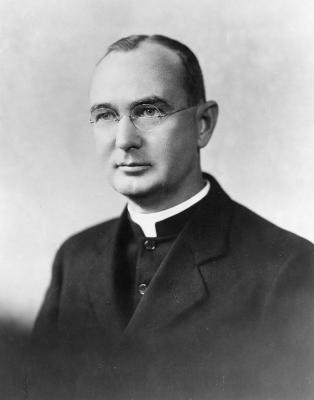President: 1935-1942
Fr. Arthur O'Leary, S.J., served as Georgetown's 40th president from 1935-1942. Fr. O'Leary enacted significant administrative reforms and made efforts to improve alumni engagement and student life.
Early Life and Academic Career
Fr. Arthur O’Leary was born in Washington, DC and attended the Jesuit-run Gonzaga High School. In 1903, at the age of sixteen, he entered the Society of Jesus. Fr. O’Leary studied first at St. Andrew-on-Hudson before earning his PhD in Philosophy at Woodstock. He then taught Philosophy at Georgetown from 1916 until his ordination in 1919 in Dahlgren Chapel. 1 Fr. O’Leary returned to Georgetown in 1923 as the University's librarian. During his twelve-year tenure, Fr. O’Leary opened a library reference desk, enrolled the University in an inter-library loan system, and began a thorough catalogue of the library’s books.1
Appointment as President
In 1934, when then University president Fr. Nevils took a leave of absence from his official duties to attend the Far Eastern Conference of the Red Cross, he appointed Fr. O’Leary as acting president. When Fr. Nevils retired in 1935, he was succeeded by Fr. O’Leary. 2On November 23, 1935, Fr. O’Leary was inaugurated as Georgetown’s fortieth president. In Gaston Hall, among the presence of diplomats and representatives of the country’s top universities, University officials bestowed on Fr. O’Leary the degree of Doctor of Divinity.3
Administrative Reforms
One of Fr. O’Leary’s first official actions was to combine the position of medical school dean and regent and appoint Fr. David McCauley to the new role. Fr. McCauley raised admission standards and reduced the size of incoming classes to 100 students. Examinations were made more rigorous, so much so that over a third of the senior class failed final exams in 1939. During this time, the dental school began hosting annual alumni clinics. In 1937, the first clinic attracted almost three hundred dentists. However, the school’s dental hygienist program was discontinued that year after insufficient interest.4
Fr. O’Leary also oversaw the restructuring of the Graduate School of Arts and Sciences. All graduate education was consolidated under a dean and new professors were appointed in biology, chemistry, economics, history, and mathematics. Faculty in the new school received special offices and light teaching schedules so they could pursue scholarly work. The University limited enrollment to fifty for the 1937-1938 school year, and by the 1939-1940 school year, enrollment had risen to ninety-eight.5
Alumni and Student Life Reforms
In May of 1937, Fr. O’Leary underwent an extensive operation for kidney stones and needed five months off to recuperate. In his absence, Fr. Walsh stepped in as acting president, but Fr. O’Leary resumed his official duties in October.6Upon his return, Fr. O’Leary began revitalizing the Alumni Association and appointed James Ruby, a professor in the English department as its secretary. The University formed a formal alumni office and began a monthly publication of a four page newsletter, the Georgetown Alumni Association.
Fr. O’Leary also revived intercollegiate athletics and allowed football, track, basketball and baseball to set their own scholarship needs. Despite the University’s return to sports, the undergraduate students remained displeased by University life. In 1938, they wrote an open letter to the administration expressing their grievances about the cost of tuition, the quality of the dining hall food, and the constant discipline. The letter was accompanied by a night of student protests with torches and fireworks. The students and the administration came to an agreement soon after. The University dismissed the woman who had been in charge of student food service for the past sixteen years and converted the student dining room into a cafeteria.7
Resignation and Later Years
In 1942, after his health continued to deteriorate, Fr. O’Leary stepped down and was succeeded by Fr. Lawrence C. Gorman. Fr. O’Leary then served as pastor of Holy Trinity Church in Georgetown before becoming pastor of St. Andrew-On-Hudson. When Fr. O’Leary died in 1963, then president Fr. Bunn remembered him fondly saying, “With gentle calm and firm serenity rooted in faith and love of God, he met the recurring crises of the times; and the courage of his soul overcame the constant weakness and sufferings of delicate and uncertain health both in his term as President and during the ensuing twenty years.”8
- 1“Fr. Arthur O’Leary Appointed Rector: Named During Month of July to Succeed Rev. Coleman Nevils, S.J.” The Hoya. 9 Oct. 1935, p.1.
- 1Georgetown University (Washington, DC), Ye Domesday Booke, 1941, p. 149.
- 2“Fr. Arthur O’Leary Appointed Rector: Named During Month of July to Succeed Rev. Coleman Nevils, S.J,” p.1.
- 3“Father O’Leary to be Inaugurated President of Georgetown University.” The Hoya. 20 Nov. 1935, p.1.
- 4Emmett Curran, Robert. “Toward a Greater Georgetown, 1889–1928.” 2010, p.173.
- 5Id. at pp. 185-87.
- 6“Rev. Father Rector Returns After Serious Illness.” The Hoya. 20 Oct. 1937, p.1.
- 7“Toward a Greater Georgetown, 1889–1928,” p.162.
- 8Frederick, Joe. “Fr. O’Leary’s Passing Mourned on Campus.” The Hoya. 15 Feb.1962, p.4.


